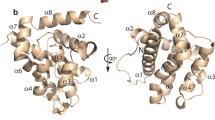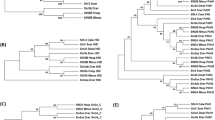Abstract
The Caenorhabditis elegans gene ced-9 prevents cells from undergoing programmed cell death and encodes a protein similar to the mammalian cell-death inhibitor Bcl-2 (refs 1,2,3,4,5,6,7). We show here that the CED-9 protein is a substrate for the C. elegans cell-death protease CED-3 (refs 8, 9), which is a member of a family of cysteine proteases first defined by CED-3 and human interleukin-1β converting enzyme (ICE)10,11,12. CED-9 can be cleaved by CED-3 at two sites near its amino terminus, and the presence of at least one of these sites is important for complete protection by CED-9 against cell death. Cleavage of CED-9 by CED-3 generates a carboxy-terminal product that resembles Bcl-2 in sequence and in function. Bcl-2 and the baculovirus protein p35, which inhibits cell death in different species through a mechanism that depends on the presence of its cleavage site for the CED-3/ICE family of proteases9,13,14,15,16,17, inhibit cell death additively in C. elegans. Our results indicate that CED-9 prevents programmed cell death in C.elegans through two distinct mechanisms: first, CED-9 may, by analogy with p35 (refs 9, 17), directly inhibit the CED-3 protease by an interaction involving the CED-3 cleavage sites in CED-9; second, CED-9 may directly or indirectly inhibit CED-3 by means of a protective mechanism similar to that used by mammalian Bcl-2.
This is a preview of subscription content, access via your institution
Access options
Subscribe to this journal
Receive 51 print issues and online access
$199.00 per year
only $3.90 per issue
Buy this article
- Purchase on Springer Link
- Instant access to full article PDF
Prices may be subject to local taxes which are calculated during checkout

Similar content being viewed by others
References
Hengartner, M. O., Ellis, R. E. & Horvitz, H. R. Caenorhabditis elegans gene ced-9 protects cells from programmed cell death. Nature 356, 494–499 (1992).
Hengartner, M. O. & Horvitz, H. R. C. elegans cell survival gene ced-9 encodes a functional homolog of the mammalian proto-oncogene bcl-2. Cell 76, 665–676 (1994).
Cleary, M. L., Smith, S. D. & Sklar, J. Cloning and structural analysis of cDNAs for bcl-2 and a hybrid bcl-2/immunoglobulin transcript resulting from the t(14; 18) translocation. Cell 47, 19–28 (1986).
Tsujimoto, Y. & Croce, C. M. Analysis of the structure, transcripts, and protein products of bcl-2, the gene involved in human follicular lymphoma. Proc. Natl Acad. Sci. USA 83, 5214–5218 (1986).
Vaux, D. L., Cory, S. & Adams, J. M. Bcl-2 gene promotes haemopoietic cell survival and cooperates with c-myc to immortalize pre-B cells. Nature 335, 440–442 (1988).
Hockenbery, D., Nunez, G., Milliman, C., Schreiber, R. D. & Korsmeyer, S. J. Bcl-2 is an inner mitochondrial membrane protein that blocks programmed cell death. Nature 348, 334–336 (1990).
Nunez, G. et al. Deregulated Bcl-2 gene expresison selectively prolongs survival of growth factor-deprived hemopoietic cell lines. J. Immunol. 144, 3602–3610 (1990).
Yuan, J., Shaham, S., Ledoux, S., Ellis, H. M. & Horvitz, H. R. The C. elegans cell death gene ced-3 encodes a protein similar to mammalian interleukin-1 beta-converting enzyme. Cell 75, 641–652 (1993).
Xue, D. & Horvitz, H. R. Inhibition of the Caenorhabditis elegans cell-death protease CED-3 by a CED-3 cleavage site in baculovirus p35 protein. Nature 377, 248–251 (1995).
Thornberry, N. A. et al. Anovel heterodimeric cysteine protease is required for interleukin-1β processing in monocytes. Nure 356, 768–774 (1992).
Cerretti, D. P. et al. Molecular cloning of the interleukin-1β converting enzyme. Science 256, 97–100 (1992).
Alnemri, E. S. et al. Human ICE/CED-3 protease nomenclature. Cell 87, 171 (1996).
Clem, R. J., Fechheimer, M. & Miller, L. K. Prevention of apoptosis by a baculovirus gene during infection of insect cells. Science 254, 1388–1390 (1991).
Rabizadeh, S., LaCount, D. J., Friesen, P. D. & Bredesen, D. E. Expression of the baculovirus p35 gene inhibits mammalian neural cell death. J. Neurochem. 61, 2318–2321 (1993).
Sugimoto, A., Friesen, P. D. & Rothman, J. H. Baculovirus p35 prevents developmentally programmed cell death and rescues a ced-9 mutant in the nematode Caenorhabditis elegans. EMBO J. 13, 2023–2028 (1994).
Hay, B. A., Wolff, T. & Rubin, G. M. Expression of baculovirus P35 prevents cell death in Drosophila. Development 120, 2121–2129 (1994).
Bump, N. J. et al. Inhibition of ICE family proteases by baculovirus anti-aptptotic protein p35. Science 269, 1885–1888 (1995).
Xue, D., Shaham, S. & Horvitz, H. R. The Caenorhabditis elegans cell-death protein CED-3 is a cysteine protease with substrate specificities similar to those of the human CPP32 protease. Genes Dev. 10, 1073–1083 (1996).
Nicholson, D. W. ICE/CED-3-like proteases as therapeutic targets for the control of inappropriate apoptosis. Nature Biotechnol. 14, 297–301 (1996).
Vaux, D. L., Weissman, I. L. & Kim, S. K. Prevention of programmed cell death in Caenorhabditis elegans by human bcl-2. Science 258, 1955–1957 (1992).
Yin, X. M., Oltvai, Z. N. & Korsmeyer, S. J. BH1 and BH2 domains of Bcl-2 are required for inhibition of apoptosis and heterodimerization with Bax. Nature 369, 321–323 (1994).
Hengartner, M. O. & Horvitz, H. R. Activation of C. elegans cell death protein CED-9 by an amino-acid substitution in a domain conserved in Bcl-2. Nature 369, 318–320 (1994).
Shaham, S. & Horvitz, H. R. Developing Caenorhabditis elegans neurons may contain both cell-death protective and killer activities. Genes Dev. 10, 578–591 (1996).
Ellis, H. M. & Horvitz, H. R. Genetic control of programmed cell death in the nematode C. elegans. Cell 44, 817–829 (1986).
Yuan, J. & Horvitz, H. R. The Caenorhabditis elegans cell death gene ced-4 encodes a novel protein and is expressed during the period of extensive programmed cell death. Development 116, 309–320 (1992).
Chinnaiyan, A. M., O'Rourke, K., Lane, B. R. & Dixit, V. M. Interaction of CED-4 with CED-3 and CED-9: a molecular framework for cell death. Science 275, 1122–1126 (1997).
Spector, M. S., Desnoyers, S., Hoeppner, D. J. & Hengartner, M. O. Interaction between the C. elegans cell-death regulators CED-9 and CED-4. Nature 385, 653–656 (1997).
Wu, D., Wallen, H. D. & Nunez, G. Interaction and regulation of subcellular localization of CED-4 by CED-9. Science 275, 1126–1129 (1997).
Sambrook, J., Fritsch, E. F. & Maniatis, T. Molecular Cloning: A Laboratory Manual 2nd edn(Cold Spring Harbor Laboratory Press, Cold Spring Harbor, New York, (1989)).
Reed, J. C. Double identity for proteins of the Bcl-2 family. Nature 387, 773–776 (1997).
Acknowledgements
We thank members of H.R.H.'s laboratory for comments about the manuscript and the MIT Biopolymers Laboratory for microsequencing analysis. D.X. was supported by postdoctoral fellowships from the Anna Fuller Fund and the Helen Hay Whitney Foundation and is a recipient of a Burroughs Wellcome Fund Career Award in the Biomedical Sciences. H.R.H. is an Investigator of the Howard Hughes Medical Institute.
Author information
Authors and Affiliations
Corresponding author
Rights and permissions
About this article
Cite this article
Xue, D., Horvitz, H. Caenorhabditis elegans CED-9 protein is a bifunctional cell-death inhibitor. Nature 390, 305–308 (1997). https://doi.org/10.1038/36889
Received:
Accepted:
Issue Date:
DOI: https://doi.org/10.1038/36889
This article is cited by
-
Somatic PMK-1/p38 signaling links environmental stress to germ cell apoptosis and heritable euploidy
Nature Communications (2022)
-
BCL2L13: physiological and pathological meanings
Cellular and Molecular Life Sciences (2021)
-
Regulation of CED-3 caspase localization and activation by C. elegans nuclear-membrane protein NPP-14
Nature Structural & Molecular Biology (2016)
-
Programmed cell death and clearance of cell corpses in Caenorhabditis elegans
Cellular and Molecular Life Sciences (2016)
-
Coordination of mitophagy and mitochondrial biogenesis during ageing in C. elegans
Nature (2015)
Comments
By submitting a comment you agree to abide by our Terms and Community Guidelines. If you find something abusive or that does not comply with our terms or guidelines please flag it as inappropriate.



